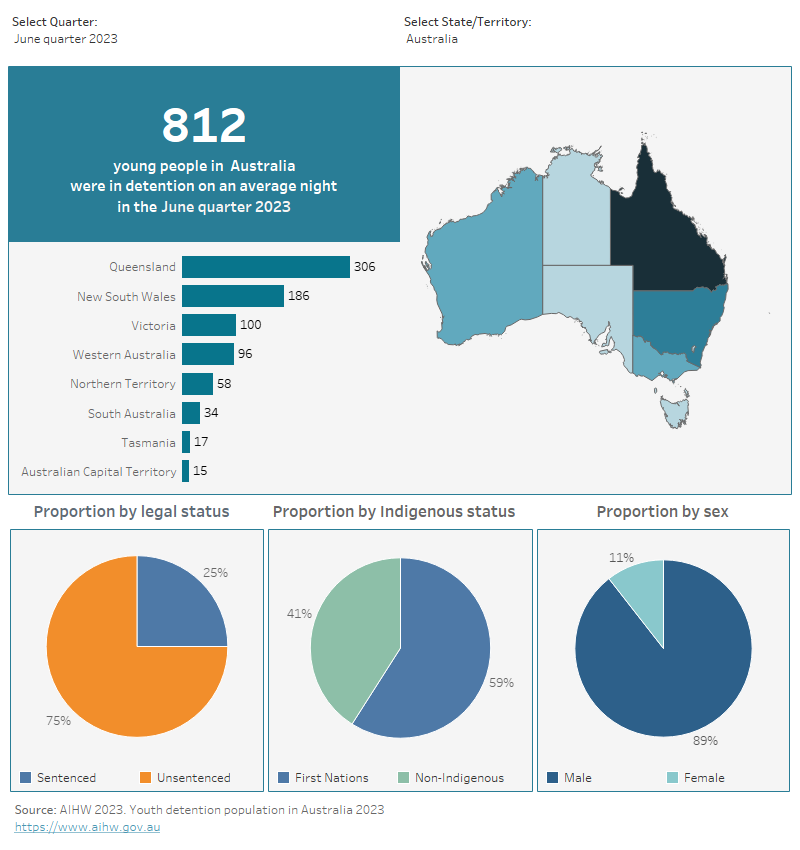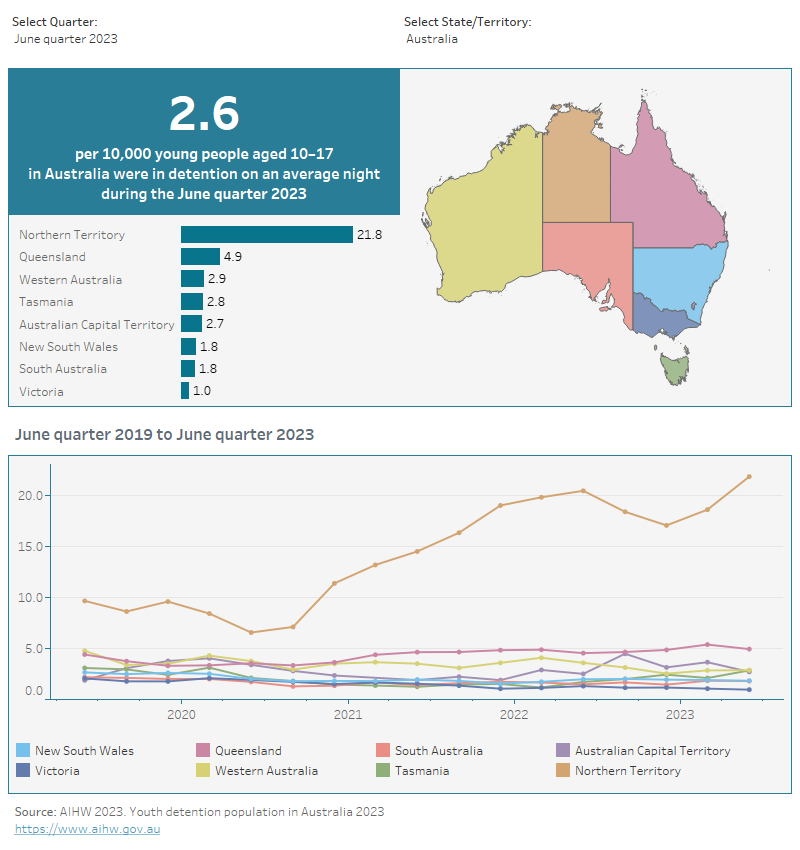Summary
On this page:
- How many young people were in detention?
- How many First Nations young people were in detention?
- How many young people aged 10–13 were in detention?
- What proportion of young people experienced unsentenced detention?
- How have numbers and rates of young people in detention changed over time?
- How have numbers and rates for young people in sentenced and unsentenced detention changed over time?
- How have patterns of youth detention changed over time in each state and territory?
How many young people were in detention?
On an average night in the June quarter 2023, 812 young Australians aged 10 and over were in detention because of their involvement, or alleged involvement, in criminal activity. The number of young people in detention has fallen, down from 941 in the June quarter 2019. Young people are most likely to be in detention if they are male, aged between 14 and 17 and are Aboriginal and Torres Strait Islander (First Nations) young people.
This report is part of an annual series and analyses the numbers and rates of young people aged 10 and over who were in youth detention in Australia. It focuses on trends over the 4-year period from the June quarter 2019 to the June quarter 2023 and precludes any change to the age of criminal responsibility by states and territories.
A better understanding of the characteristics and seasonal trends of young people in detention can help support staff, case workers and policy makers to get the best outcomes for these young people. The data may have important policy implications for the age of criminal responsibility among young people.
All data presented in this report are available through the online supplementary tables on Data.
For more information see Youth detention data and Raising the age of criminal responsibility.
Figure 1: Number of young people in detention on an average night in Australia
Of the 812 young people who were in detention on an average night, most were unsentenced, First Nations and male. Queensland had the highest number of young people in detention.

Notes
- These data are not comparable to those published in previous editions of Youth detention population in Australia. Previous editions contained differences in data formats, specifications, definitions and/or quality across jurisdictions. Further details are provided under Technical notes.
- A small number of young people are reported as having unknown Indigenous status, so some proportions will not sum to 100%.
- Average day numbers and proportions may not sum to 100% due to rounding.
- Trends among small populations should be interpreted with caution. Numbers tend to fluctuate from quarter to quarter due to random variation, and this might affect the appearance and interpretation of trends.
- The legal status pie chart for June quarter 2023 excludes Northern Territory data as data for young people in detention by legal status were not available.
Of the 812 young people in detention on an average night in the June quarter 2023, almost 9 in 10 (89%) were male and almost 6 in 10 were First Nations young people (59%).
For more information visit How many young people were in youth detention?
How many First Nations young people were in detention?
The Australian Institute of Health and Welfare (AIHW) uses 'First Nations people' to refer to Aboriginal and Torres Strait Islander people in this report.
There were 478 First Nations young people in detention on an average night in the June quarter 2023 aged 10 and over. Of all young people aged 10–17 in detention during this period, 3 in 5 (63%, or 436 of 689) were First Nations young people, yet First Nations young people made up just 5.7% of the Australian population aged 10–17.
The rate of First Nations young people aged 10–17 in detention dropped between the June quarter 2019 and the June quarter 2023 (31 to 29 per 10,000). However, First Nations young people were 29 times as likely as non-Indigenous young people to be in detention in the June quarter 2023 (compared with 22 times as likely in the June quarter 2019).
First Nations people have a long history of over-representation in the youth and adult justice systems in Australia. This over-representation reflects a history of trauma, cultural dispossession, and forced displacement and assimilation that have affected them, their parents, families and communities.
For more information see First Nations young people.
How many young people aged 10–13 were in detention?
A very small number of young people aged 10–13 were in detention. This number has fallen – from 52 in the June quarter 2019 to 41 in the June quarter 2023.
The rate of young people aged 10–13 in detention on an average night in the June quarter 2023 was 0.3 per 10,000. For First Nations people aged 10–13 the rate was 4.0 per 10,000 and for young non-Indigenous Australians the rate was 0.1 per 10,000.
Of First Nations young people in detention, 6.3% were aged 10–13. The proportion of non-Indigenous young people in detention aged 10–13 was lower (3.3%).
For more information see Trends in detention and How old were First Nations young people in detention?
What proportion of young people experienced unsentenced detention?
Almost 4 in 5 (77%) young people in detention on an average night in the March quarter 2023 were unsentenced – that is, they were awaiting their initial court appearance or sentencing. The remainder were serving a sentence. (June quarter 2023 data for legal status were unavailable for the Northern Territory, so March quarter 2023 data were used for national reporting).
For more information see Trends in sentenced and unsentenced detention.
In Australia, young people who are charged with, or proven guilty of, criminal offences may be supervised by state and territory youth justice agencies. Supervision may take place either in the community or in detention facilities.
This report looks at trends in the numbers and rates of young people in secure detention facilities in Australia due to their involvement or alleged involvement in crime.
Young people might be in detention while they are:
- unsentenced – that is, awaiting their initial court appearance, or awaiting sentencing after being found or pleading guilty
- sentenced – when they have been found guilty in court and have received a legal order to serve a period of detention.
Whether a young person is unsentenced or sentenced is known as their ‘legal status’.
How have numbers and rates of young people in detention changed over time?
Over the 4-year period from the June quarter 2019 to the June quarter 2023, the number of young people in detention on an average night fell from 941 to 812. In the June quarter 2023, the rate of young people aged 10–17 in detention on an average night was 2.6 per 10,000. This rate was lower than in the June quarter 2019 (3.2 per 10,000) and slightly lower than in the June quarter 2022 (2.7 per 10,000).
For more information see How did the number of young people in youth detention change over time?
How have numbers and rates for young people in sentenced and unsentenced detention changed over time?
Northern Territory youth detention population data for legal status were not available for the June quarter 2023. This section therefore uses the March quarter 2023 data for national reporting. March and June quarters are sufficiently comparable as past data indicates that differences based on seasonal trends are minimal for these time periods.
From the June quarter 2019 to the March quarter 2023, the proportion of those in unsentenced detention increased from 63% to 77% while the proportion of those in sentenced detention decreased from 37% to 23%.
In the March quarter 2023, there were 2.3 per 10,000 young people aged 10–17 in unsentenced detention on an average night, and 0.5 per 10,000 in sentenced detention.
The rate of young people in unsentenced detention fluctuated over time. It was lowest in the September quarter 2020 (1.7 per 10,000), and highest in the March quarter 2023 (2.3 per 10,000).
The rate of young people aged 10–17 in sentenced detention fell from 0.9 per 10,000 in the June quarter 2019 to 0.5 per 10,000 in the March quarter 2023.
For more information see Trends in sentenced and unsentenced detention.
How have patterns of youth detention changed over time in each state and territory?
Over the 4-year reporting period, the Northern Territory consistently had the highest rate of young people in detention on an average night each quarter (6.6–22 per 10,000 aged 10–17). This rate was at its peak in the June quarter 2023 (22 per 10,000) and lowest in the June quarter 2020 (6.6 per 10,000).
In this period, there were declines in the rate of young people in detention on an average night in New South Wales, Victoria, Western Australia, and South Australia. Rates of young people in detention on an average night increased in Queensland and the Northern Territory.
For the Australian Capital Territory and Tasmania, these rates fluctuated over the 4-year period and showed no clear trend.
For more information see State and territory trends.
Figure 2: Rates of young people in detention on an average night in Australia
The Northern Territory rate of young people aged 10–17 in detention on an average night has been increasing since 2020 and is much higher than the national rate.

Notes
- These data are not comparable to those published in previous editions of Youth detention population in Australia. Previous editions contained differences in data formats, specifications, definitions and/or quality across jurisdictions. Further details are provided under Technical notes.
- Trends among small populations should be interpreted with caution. Numbers tend to fluctuate from quarter to quarter due to random variation, and this might affect the appearance and interpretation of trends.
- Rates are not published where there were fewer than 5 young people.


